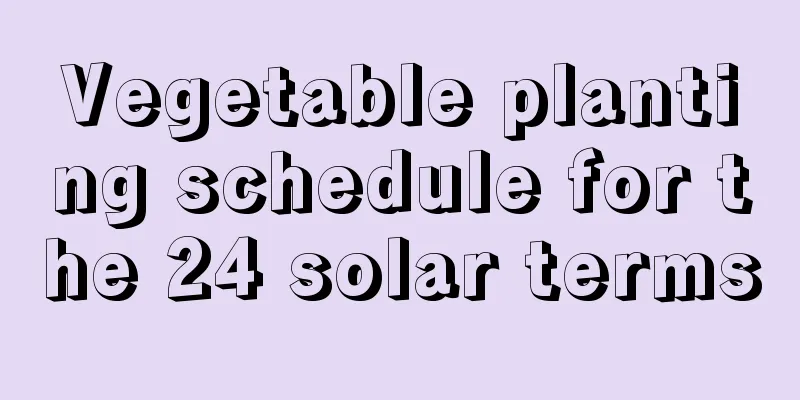Vegetable planting schedule for the 24 solar terms

|
The 24 solar terms are an important time division in the Chinese lunar calendar used to guide farming activities. If many farmer friends don’t know when to plant what vegetables, they can refer to the 24 solar terms vegetable planting schedule. Beginning of Spring (February 4th or 5th): sowing of spring onions and open-field spring tomato seedlings (early February), sowing of spring zucchini seedlings (early February), and sowing of spring cabbage seedlings in protected areas (early February). Rainwater (February 19th or 20th): sowing of spring onions, sowing of spring potatoes (late February), sowing and raising of watermelon seedlings under ground film and sky film (late February), sowing and raising of zucchini seedlings in small greenhouses. Jingzhe (March 5 or 6): Greenhouse tomatoes, peppers, eggplants, and cucumbers begin to be planted, while cucumbers, zucchini, and tomatoes that overwinter in the greenhouse should pay attention to top dressing, watering, and strengthening disease and pest control during this period. Spring Equinox (March 20 or 21): Greenhouse tomatoes , peppers, eggplants, and cucumbers continue to be planted, and watermelons that were planted early in the spring in the open field begin to be raised in small greenhouses. Qingming Festival (April 4 or 5): Early spring cucumbers and zucchini in greenhouses are gradually coming on the market. Greenhouse tomatoes and cucumbers are in their peak production period. Caterpillars begin to appear on open-field vegetables, so pay attention to prevention and control. Grain Rain (April 20 or 21): Open-field Solanaceae vegetables begin to be transplanted into the field; Zucchini planted in advance in small greenhouses should have better ventilation to avoid excessive growth in the greenhouse. Beginning of Summer (May 5 or 6): Greenhouse vegetables should be ventilated day and night, and water and fertilizer management should be strengthened, while disease and pest control of various vegetables should be strengthened. Grain Full (May 21 or 22): In the first and middle ten days of the month, you should hurry up and plant watermelon, pepper, eggplant and other vegetables to be intercropped in wheat fields. The intercropping time should be 20 to 25 days before the wheat harvest. Grain in Ear (June 5th or 6th): June has entered summer, and the average monthly temperature can reach 25℃~26℃. Most of the fruits and vegetables in the greenhouse have been pulled out, and the diseased and damaged parts in the greenhouse should be cleaned up. Summer Solstice (June 21 or 22): At this time, the wheat in the Central Plains has been harvested. Select some heat-resistant and disease-resistant vegetable varieties and sow them in time. Lesser Heat (July 7 or 8): July has changeable weather, so we must irrigate during droughts and drain water during floods. This period is a critical period for raising seedlings of open-field cauliflower, cabbage, and autumn greenhouse tomatoes, peppers, and eggplants. Great Heat (July 22nd or 23rd): Continue to cultivate the autumn-delayed pepper seedlings : The end of June to July 20th is the seedling raising period for the autumn-delayed pepper in greenhouses. Beginning of Autumn (August 7 or 8): August is still hot and rainy. In production, we should avoid high temperature and high humidity in the early stage, focus on high yield in the later stage, and do a good job in autumn planting. End of Heat (August 23 or 24): Early autumn cabbage can still be sown in early August and can be put on the market early. The best sowing time for winter storage Chinese cabbage is mid-to-late August. White Dew (September 7 or 8): We must seize the favorable opportunity to manage the autumn vegetables in the fields and do a good job in winter sowing and raising vegetable seedlings in protected areas. Autumnal Equinox (September 22 or 23): Onion seedlings are grown in northern Henan around the "White Dew" period, while in southern Henan the period can be delayed to mid-to-late September; green onion seedlings are grown around the Autumnal Equinox. Cold Dew (October 8 or 9): The average monthly temperature in northern China has dropped to around 15°C. Frost has begun to fall in late October and warm-loving vegetables are entering the final harvest period. Frost Descent (October 23rd or 24th): In early to mid-October, a large batch of zucchini seedlings begin to be raised in the solar greenhouse. The seedlings are 15 to 20 days old. Beginning of Winter (November 7 or 8): The outdoor planting of warm-loving vegetables has ended. For semi-cold-resistant vegetables, it is important to seize the opportunity and do a good job of pre-harvest management. Light Snow (November 22 or 23): Do a good job of clearing the field for warm-loving vegetables such as tomatoes, cucumbers, peppers, eggplants, potatoes, etc. Heavy snow (December 7 or 8): It is winter outside, but it is spring in the greenhouse. Work in December was concentrated in the greenhouse and nursery shed. Winter Solstice (December 21st or 22nd): In early December, use greenhouses and hotbeds to grow tomato, eggplant, and pepper seedlings. The seedlings are 90 to 100 days old and are transplanted into large or medium-sized greenhouses when large buds appear in early to mid-March. However, everyone should note that this timetable is a general guide, and the specific planting time may vary depending on regional climate conditions, soil type, and planting methods. During actual planting, adjustments should be made based on local conditions.
|
>>: How to fertilize Kalanchoe, symptoms of overfertilization
Recommend
Is the fortune tree acidic or alkaline? Should it be grown indoors or outdoors?
1. Acidic or alkaline The money tree is a plant t...
How to grow Chinese toon
1. Maintenance methods 1. Temperature: Its normal...
How to grow hydroponic spider plants well?
As a common indoor plant, many people try to grow...
How much is a pound of Pinellia, the price of Pinellia
1. Price There are certain differences in the qua...
How to plant roses
1. Prepare the soil When planting roses, you need...
How to propagate Phalaenopsis seedlings
1. Flower stalk germination propagation method ① ...
How to prolong the flowering period of Phalaenopsis
soil First of all, you need to choose the right s...
How and when to plant beans
Bean planting time and month When to plant beans ...
What tree is not afraid of flooding?
1. Weeping Willow This type of tree often grows b...
When is the best time to plant autumn cucumbers?
Planting autumn cucumbers is favored by many grow...
Can bamboo be grown in Beijing?
Can bamboo be grown in Beijing? Bamboo can be pla...
How to prune hydrangeas?
In the process of caring for hydrangeas , pruning...
Cultivation methods and precautions of Chinese boxing ginseng
1. Lighting The boxwood prefers a cool growing en...
What is the reason for the dry leaves of gardenia
1. The temperature is too low The temperature in ...
Cultivation methods and precautions of water shield
1. Maintenance methods 1. Fertilizer: If there is...









